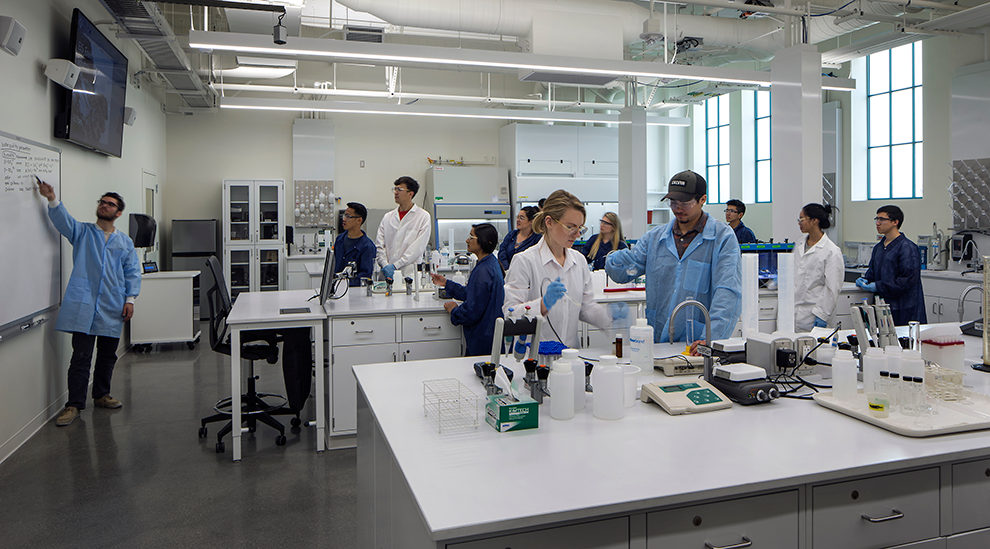New Research Center Focusing on Augmented, Mixed Reality
The newly created Virtual Immersive Teaching and Learning (VITaL) Research Center will drive the concept of reality-virtual teaching and learning.

With augmented and virtual reality playing a larger role in everyday life, San Diego State University has launched a new research center dedicated to expanding the use of emergent virtual technologies in the classroom.
The Information Technology Division has launched Virtual Immersive Teaching and Learning (VITaL) as a formal research center. Its faculty and staff will expand research to develop and integrate new and innovative teaching and learning practices, spark technological innovation and research in the field of eXtended Reality (XR). This includes virtual, augmented and mixed reality immersive learning tools.
“This is about evolving the traditional learning environment and harnessing the tremendous power of immersive technologies to dramatically increase learner attention by increasing student engagement,” said Jerry Sheehan, vice president for Information Technology.
“SDSU is a national leader in driving innovation, creativity, and collaboration that would be impossible or out of reach in traditional learning environments,” Sheehan said.
The mission of the VITaL Center is to improve teaching, learning and student success through state-of-the-art technological tools and resources, said James Frazee, deputy chief information officer and senior associate vice president for Learning Environments, Technologies & User Services (LETUS), a unit within the IT Division.
The research center's faculty and staff will involve students in collaborative projects to design, develop, research and engage with XR while leveraging new technologies in hardware, software, artificial intelligence and machine learning.
“The VITaL Center will create and leverage open, affordable, and inclusive immersive learning resources to serve a diverse community of learners,” Frazee said.
Living Laboratories
Instructional Technology Services, a unit within the SDSU Information Technology Division, launched the VITaL initiative in fall 2017. This initiative served as an incubator for faculty and staff to create new and innovative experiences.
Faculty created new ways of teaching through the use of XR applications, to include the creation of low-frequency, high-risk scenarios.
Some simulated life-threatening medical conditions, created interactive moon phase simulations for astronomy students and created virtual anatomy lab specimens for distance learning.
Other faculty created a custom application demonstrating interactions between nano materials for mechanical engineering students, animated three-dimensional models of molecules and magnetic fields for chemistry and physics students, and developed an award-winning virtual holographic patient simulating anaphylactic shock for nursing students.
Beyond these examples, VITaL resources have been utilized by 56 faculty teaching 70 courses across all eight colleges at SDSU. This widespread adoption provided a living laboratory for research that has resulted in several awards, grant funding, peer-reviewed publications, and invited presentations, as well as national and international press coverage. Collaborations with student organizations and industry partners have resulted in career pathways for SDSU students at top employers.
“These experiences have been particularly valuable for students at rural SDSU Imperial Valley who do not have access to the same traditional simulation facilities available for students at the San Diego campus,” Frazee said.
The new VITaL Research Center will foster even more interdisciplinary research to create more of these types of new teaching and learning opportunities, to include the development of new public-private partnerships across academia and industry. The center will focus on both the San Diego and Imperial Valley border (U.S.-Mexico) region, involving faculty, staff and students at both SDSU and SDSU Imperial Valley.
Why Now?
A growing body of research indicates that the use of immersive technology simulation fosters student success through increased learner confidence, emotional connection and motivation to learn, said Sean Hauze, the Instructional Technology Services director, whose own research at SDSU has demonstrated such findings.
In addition, a landmark study from PricewaterhouseCoopers (PwC) suggests that simulation based learning in VR allows for quicker yet deeper focused learning compared with traditional classroom or e-learning environments, said Hauze, also a lecturer in the School of Education’s Department of Educational Leadership.

These findings are increasingly relevant given the rapid acceleration of the adoption of technology during the novel coronavirus 2019 (COVID-19) pandemic, Hauze said.
“As a result, post-secondary education is in the midst of unprecedented change,” Hauze said. “In light of these new realities, universities must provide flexible, customizable, technology-enhanced learning opportunities that allow students to maintain access to high quality instruction. These needs are driving higher education leaders and faculty to rethink instruction to help faculty plan courses that offer a purposeful blend of face-to-face and online modalities to promote active learning and student engagement.”
Call for Grant Proposals
The VITaL Research Center Grant and Faculty Fellowship is focused on major, long-term fundamental immersive learning research challenges. Fellows will produce transformative research that leads to innovation, and attracts broad scientific and public interest at SDSU, in the border region, nationally and internationally.
The VITaL Research provides an agile structure that can respond rapidly to emerging opportunities through enhanced collaborations, and the grant award winner will play a strategically important role with the launch of the center. The awardees will integrate research, innovation, and education, and will broaden participation, and extend communication within the SDSU community.
The VITaL Faculty Fellowship is open to all faculty members at SDSU. The university particularly encourages fundamental research and development of projects aligned with budget priorities, specifically including impact on historically challenging (high DFW) courses with a focused evaluative criteria on the potential for transformative impact in teaching and learning. Faculty should submit a preliminary proposal on or before Feb. 28.



